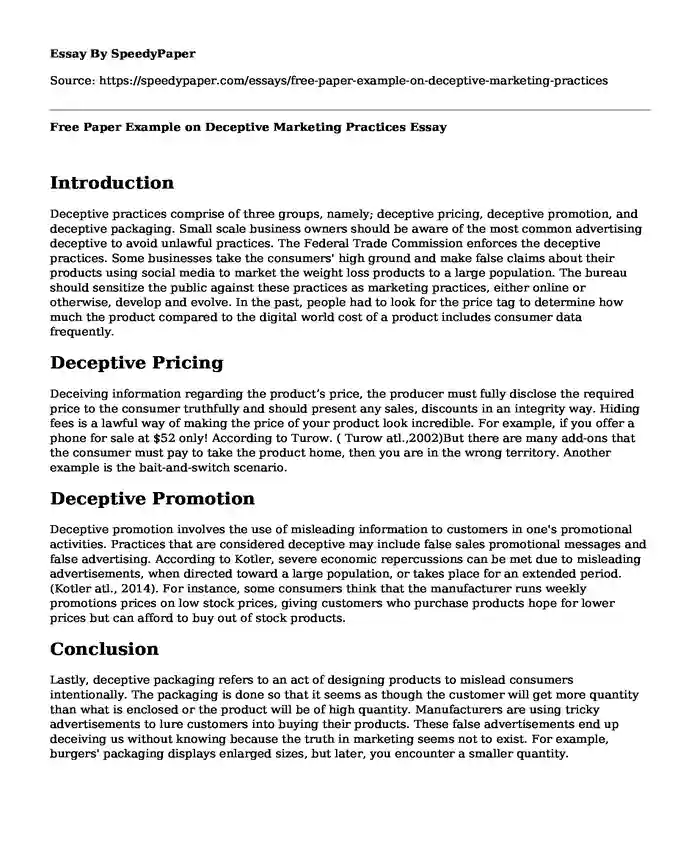
| Type of paper: | Essay |
| Categories: | Marketing Social issue |
| Pages: | 2 |
| Wordcount: | 428 words |
Introduction
Deceptive practices comprise of three groups, namely; deceptive pricing, deceptive promotion, and deceptive packaging. Small scale business owners should be aware of the most common advertising deceptive to avoid unlawful practices. The Federal Trade Commission enforces the deceptive practices. Some businesses take the consumers' high ground and make false claims about their products using social media to market the weight loss products to a large population. The bureau should sensitize the public against these practices as marketing practices, either online or otherwise, develop and evolve. In the past, people had to look for the price tag to determine how much the product compared to the digital world cost of a product includes consumer data frequently.
Deceptive Pricing
Deceiving information regarding the product’s price, the producer must fully disclose the required price to the consumer truthfully and should present any sales, discounts in an integrity way. Hiding fees is a lawful way of making the price of your product look incredible. For example, if you offer a phone for sale at $52 only! According to Turow. ( Turow atl.,2002)But there are many add-ons that the consumer must pay to take the product home, then you are in the wrong territory. Another example is the bait-and-switch scenario.
Deceptive Promotion
Deceptive promotion involves the use of misleading information to customers in one's promotional activities. Practices that are considered deceptive may include false sales promotional messages and false advertising. According to Kotler, severe economic repercussions can be met due to misleading advertisements, when directed toward a large population, or takes place for an extended period. (Kotler atl., 2014). For instance, some consumers think that the manufacturer runs weekly promotions prices on low stock prices, giving customers who purchase products hope for lower prices but can afford to buy out of stock products.
Conclusion
Lastly, deceptive packaging refers to an act of designing products to mislead consumers intentionally. The packaging is done so that it seems as though the customer will get more quantity than what is enclosed or the product will be of high quantity. Manufacturers are using tricky advertisements to lure customers into buying their products. These false advertisements end up deceiving us without knowing because the truth in marketing seems not to exist. For example, burgers' packaging displays enlarged sizes, but later, you encounter a smaller quantity.
References
Armstrong, G., Adam, S., Denize, S., & Kotler, P. (2014). Principles of marketing. Pearson Australia. http://41.33.248.151/bitstream/handle/123456789/4064/11040.pdf?sequence=1&isAllowed=y
McAllister, M. P., & Turow, J. (2002). New media and the commercial sphere: Two intersecting trends, five categories of concern. Journal of Broadcasting & Electronic Media, 46(4), 505-514.
https://www.reference.com/business-finance/deceptive-pricing-bcd37ce08f2bf508.
Cite this page
Free Paper Example on Deceptive Marketing Practices. (2023, Nov 24). Retrieved from https://speedypaper.com/essays/free-paper-example-on-deceptive-marketing-practices
Request Removal
If you are the original author of this essay and no longer wish to have it published on the SpeedyPaper website, please click below to request its removal:
- Essay Example on Why Use Social Media for Business
- Essay Sample on Women in Prison: Who Takes Care of the Children?
- Essay Sample about Adidas' Content Marketing in Social Media
- Essay Sample on Heroin Mitigation
- Paper Example: Same-Sex Classrooms
- Major Threats to America. Free Essay Example
- A Short Narrative of My Life - Essay Sample
Popular categories




